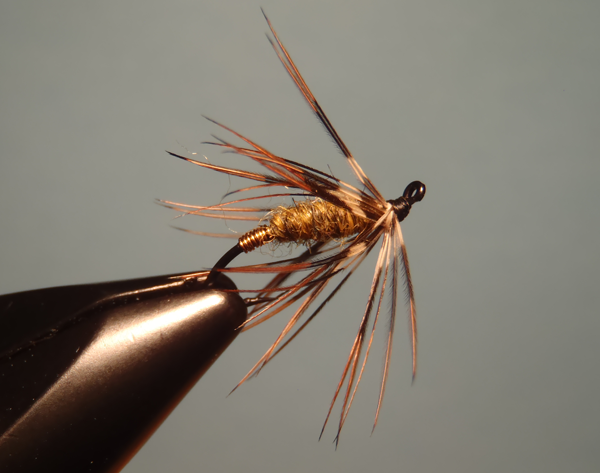I haven’t tied a lot of tenkara flies with yarn bodies but Chris Stewart of Tenkara Bum certainly has. In fact, he’s inspired a whole subculture of yarners with his recent blue fly challenge. Chris sent me some samples of some of the yarns he sells and I can immediately see their advantages:
1. Yarn is easy to tie with. You can easily build up a bulky body if you want, or separate the strands to make a more slender body by untwisting the strands. That’s pretty versatile.
2. Yarn absorbs water. That means your fly will sink faster without having to add weight.
3. It’s Buggy. The stray strands of most yarns just make a fly look “buggier” underwater. They suggest legs, antennae, tails, and all other sorts of accoutrements aquatic insects are decked out with. Plus, many fibers become translucent underwater and trap air, suggesting many characteristics of emergence that are also attractive to trout.
4. Yarn is very durable. We’ve all had flies that have been chewed up by trout, trees, or forceps. Yarn bodies are much better at fending off these offenders.
5. It’s cheap. I can buy a lifetime supply of yarn for about $2. Compared to the going price of a small packet of fancy dubbing at $5 or $6, I”m sold.
I could go on and on about the virtues of yarn-based flies but I think you get the point. If you like the look of the fly in the picture above, the recipe is below. Let your imagination substitute different materials and different colors of materials to make it your own.
Recipe
Hook: Orvis Up-eye Nymph (discontinued)
Thread: Uni 8/0, black
Tag: Small Gold Wire
Body: Bracken Yarn
Hackle: Pheasant









Jason,
Long live yarn bugs!!! I just love them, hackle or no hackle. Thanks for singing their praises with your blog post. Nice hook on that pattern too. I haven’t seen it used.
Paul, that hook has a nice, black finish, good bend, and is very unique. It’s almost like a miniature salmon hook from Partridge. Orvis came out with them years ago and I have a stock but have not been able to find anyone who makes them anymore.
That fly looks great Jason, and I like the way that you are using the hackle, on the sparse side. I agree wholeheartedly. I have had a lot of success with yarn body flies, especially the Sakakibara. One of my most popular sellers, and one that I use regularly and recommend to customers is the Utah Killer Bug. How can something be so simple and yet so effective? It’s almost to good to be true. Thank you Frank Sawyer, and thank you Chris Stewart for your work in promoting the use of yarn in tenkara kebari.
Thanks James! Though I think you mean “sakasa kebari” rather than “sakakibara”, right? The thing is, tying with yarn is simple. But if you put yarn under the microscope, it’s actually quite a complicated thing. Good for us that all the hard work is done for us ahead of time in the manufacturing process and all we have to do is wrap it around a hook. I like that.
nice report. gonna tie some myself this weekend.
Great post Jason. I agree with all of it wholeheartedly. With one or two exceptions yarn bodied flies are becoming my go to favorites. To date, my best producer has been a simple Killer Bug. BTW…very nice tie.
I actually use yarn as dubbing. I actually cut it up fine then align it like you do with normal dubbing. Not as good as rabbit dubbing but, it works and yarn is CHEAP. I actually bought multi colored yarn so about every foot is a different color, brown, tan, green, yellow. I did a little write up about it here http://diyflyfishingandflytying.blogspot.com/2013/03/cheap-easy-dubbing.html I also use small tuffts of the bright orange yarn for indicators on parachute adams and the like.
Jesse,
Great idea! I’ve done this before and it definitely works. But like you said, not always as easy to dub as the pre-packaged stuff. Have you ever tried making your own “blends” in a coffee grinder? You can buy one new at Target for like $10 and get pretty creative.
I haven’t yet Jason but, it is on my thrift store shopping list.
Hi Jason, hi guys! Please ignore the messy table from this guy 🙂
http://www.youtube.com/watch?v=OhTbFOmbA-8
Costin